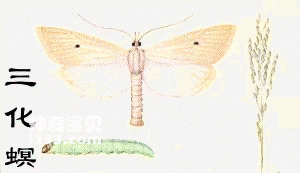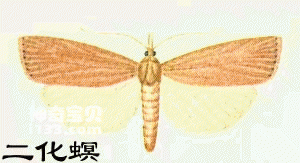The rice borer was a major enemy of rice cultivation 3,000 years ago. After being damaged, the fields are covered with white ears, the leaves and seedlings are withered, and the yield is reduced by more than half. In 1957, Zhou Yao verified in "History of Early Entomology Research in China" that borers were the largest pest in my country after locusts. Rice borers belong to the family Boreridae of the order Lepidoptera, and there are mainly two types: borer borer and borer three.

The moth is light yellow and its forewings are triangular. The female moth's forewings are yellow-white with black spots in the center, and there is an obvious cluster of yellow-brown hairs at the end of the abdomen before laying eggs. The male moth is smaller; the forewings are light grayish brown, with a black diagonal stripe on the top of the wings, a small black spot in the center, and 7-9 small black spots along the outer edge.
The egg mass is oval in shape and covered with yellowish-brown hairs on the surface.
The larvae are milky white or light yellow-green, with a transparent vertical line on the back.
The pupa is cylindrical. The end of the antennae of the female pupa is in front of the end of the forelegs, the middle legs do not extend the wing buds, and the length of the hind legs extending from the wing buds is less than half the length of the abdomen. The end of the antennae of the male pupa is behind the end of the forefoot, the middle foot extends slightly from the wing bud, and the hind foot extends the wing bud very long until near the end of the abdomen.
Moths are active at night and have strong phototaxis. On nights when the temperature is above 20°C, the wind is light, and there is no moon, most moths will flock to the lamp in the middle of the night. Female moths like to lay eggs on lush, green rice plants. They lay eggs near the tips of leaves in rice fields and in the middle and upper parts of leaves in fields. A female moth can lay more than 100-200 eggs. The newly hatched ant borers crawl on the rice plants, or spin silk and droop, and then float to neighboring rice plants in the wind. Rice seedlings are susceptible to damage from ant borers, causing dead cores. Rice seedlings that are in the peak tillering stage and have bright green leaves will suffer severe damage if they encounter fields where eggs are hatched. Rice plants that are breaking and heading are also vulnerable to ant borer damage, causing white ears. If the larvae are infested during the later stages of grain filling, the plants will be damaged by insects.
There are three or four generations a year in the suburbs of Shanghai, with mature larvae overwintering in rice piles in the fields. The overwintering larvae pupate and emerge into the overwintering generation of moths. The peak period of each generation of hair moths is: late May for the overwintering generation, early to mid-July for the first generation, and mid-to-late August for the second generation. In some years, the peak of the third generation of moths can appear from late September to early October, that is, some fourth generation larvae appear. If the temperature is high during the larval stage, the development will be faster and the moth will be born earlier. The third generation suffers the most damage throughout the year in suburban areas.
After the moth emerges, it begins laying eggs the next day. The duration of eggs: 11-12 days for the first generation, 7-8 days for the second and third generations. Larvae have four instars, and a few have five instars. The development progress of each instar of the larvae can be used as a reference for forecasting and reporting.
The larvae cause damage in the rice stem. When mature, they bore down to the base of the rice plant and pupate in the rice stem 1-2 cm below the soil surface. Before pupation, the larvae bites an eclosion hole in the rice stem to facilitate the moth to crawl out of the rice stem after emergence. The pupation progress of larvae and the development progress of pupae are important basis for current forecasting. From the color changes of the pupa, the development progress of the pupa can be divided into seven pupal stages. Based on the different temperatures at that time, the emergence date of the borer moth can be calculated.

The borer mainly damages rice and wild rice. The overwintering larvae also damage crops such as wheat, corn, rapeseed and broad beans.
The moth is grayish-brown, with rectangular forewings, light grayish-brown, and 6-7 small black spots on the outer edge.
The egg mass is oblong in shape, with irregular fish scale-like arrangements and covered with transparent colloid.
The larvae are light brown with five tan vertical lines on the back.
The pupa is cylindrical, with a slightly pointed tail end. The anal hole at the end of the abdomen of the female pupa is far away from the genital hole in front, and the distance is more than twice the length of the anal hole slit. The anal hole at the end of the abdomen of the male pupa is close to the genital pore, and the distance apart is approximately equal to the length of the anal hole slit.
The living habits of the two borers are more complicated than those of the three borers. The location where the moth lays eggs changes depending on the different growth stages of rice. Most eggs are laid on the leaves before jointing of round stalks, and on the leaf sheaths after jointing of round stalks. A female moth can lay more than 200 eggs. After the ant borer hatches, it first causes damage in the leaf sheath. If the seedlings are still small and the leaf sheaths are narrow, the concentration of larvae damage to the leaf sheaths will not be obvious; if the seedlings are thick and the leaf sheaths are wide, the ant borers and early second instars will be concentrated in the leaf sheaths. After 7 to 14 days after the ant borer hatches, the larvae enter the late second or third instar and begin to bore into the rice stems and cause damage to the plant. In severe cases, one larvae can transfer to another plant and damage 8-10 rice plants. Mature larvae pupate within the rice stem or between the stem and leaf sheaths.
There are two or three generations a year in the suburbs of Shanghai, and the larvae overwinter in straw, rice piles and wild rice. The overwintering larvae have strong vitality and can withstand dryness and cold. After the spring warms up, many larvae still penetrate into wheat, rapeseed, broad beans and other plants and cause damage. Due to differences in overwintering locations and conditions of digging into crops for supplementary feeding, the pupation progress of larvae after spring warms up varies greatly. Overwintering larvae in wild rice pupate first, followed by larvae in rice piles, straw, summer crops, etc. Larvae in rice straw piled indoors pupate last. The moth period of the overwintering generation is very long, from late April to mid-to-late July, which lasts for more than 80 days, and there are three or four peak days when moths are concentrated. The peak period of the first generation of hair moths is in early and mid-August. The hair moth period is connected with the hair moth period of the overwintering generation and is often difficult to distinguish clearly.
Rice is damaged at different growth stages, with dead sheaths, dead cores, dead boots, white ears or insect-damaged plants. After the egg masses hatch, the ant borers first swarm in the leaf sheaths and cause damage, causing the sheaths to wither. Later, the larvae disperse and cause damage to the plant, causing dead heart and insect damage. The first generation of larvae causes the most damage throughout the year.
animal tags: Rice borer pest Lepidoptera Boreidae
We created this article in conjunction with AI technology, then made sure it was fact-checked and edited by a Animals Top editor.